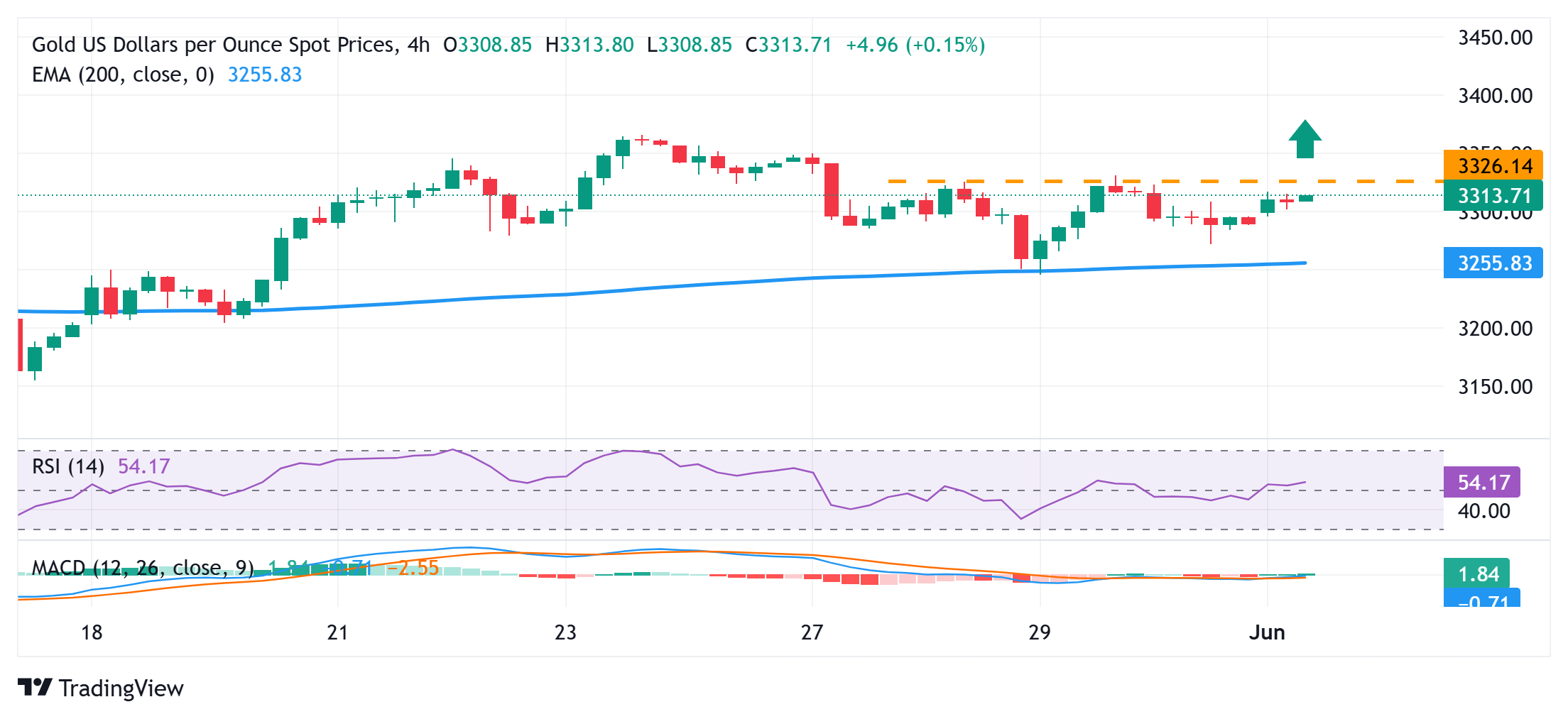Created
: 2025.06.02














![]() 2025.06.02 13:35
2025.06.02 13:35
Gold price (XAU/USD) regains positive traction at the start of a new week and climbs beyond the $3,300 mark during the Asian session, reversing a major part of Friday's losses. The Personal Consumption Expenditures (PCE) Price Index released on Friday further pointed to signs easing inflationary pressures in the US and bolstered the case for more rate cuts by the Federal Reserve (Fed). This, in turn, is seen weighing on the US Dollar (USD) and acting as a tailwind for the non-yielding yellow metal.
Meanwhile, geopolitical risks stemming from the protracted Russia-Ukraine war and conflicts in the Middle East, along with renewed US-China trade tensions, temper investors' appetite for riskier assets. This is evident from a generally weaker tone around the equity markets, which turns out to be another factor that benefits the safe-haven Gold price. However, the lack of strong follow-through buying warrants caution for the XAU/USD bulls ahead of this week's US macro releases scheduled at the start of a new month.

From a technical perspective, the XAU/USD pair is likely to confront a stiff barrier near the $3,326-3,328 supply zone. Against the backdrop of last week's bounce from the 200-period Exponential Moving Average (EMA) pivotal support on the 4-hour chart, a sustained strength beyond will be seen as a fresh trigger for bullish traders. The subsequent move up could lift the Gold price to the $3,345-3,350 intermediate resistance, above which the Gold price could aim to reclaim the $3,400 mark. The momentum could extend further towards the next relevant barrier near the $3,432-3,434 region.
On the flip side, weakness below the $3,300 round figure could find some support near the $3,280-3,278 zone. Any further slide could be seen as a buying opportunity and remain limited near the $3,258-3,257 region. The latter represents the 200-period EMA on the 4-hour chart, which if broken decisively could make the Gold price vulnerable to accelerate the fall further towards the $3,200 mark.
Gold has played a key role in human's history as it has been widely used as a store of value and medium of exchange. Currently, apart from its shine and usage for jewelry, the precious metal is widely seen as a safe-haven asset, meaning that it is considered a good investment during turbulent times. Gold is also widely seen as a hedge against inflation and against depreciating currencies as it doesn't rely on any specific issuer or government.
Central banks are the biggest Gold holders. In their aim to support their currencies in turbulent times, central banks tend to diversify their reserves and buy Gold to improve the perceived strength of the economy and the currency. High Gold reserves can be a source of trust for a country's solvency. Central banks added 1,136 tonnes of Gold worth around $70 billion to their reserves in 2022, according to data from the World Gold Council. This is the highest yearly purchase since records began. Central banks from emerging economies such as China, India and Turkey are quickly increasing their Gold reserves.
Gold has an inverse correlation with the US Dollar and US Treasuries, which are both major reserve and safe-haven assets. When the Dollar depreciates, Gold tends to rise, enabling investors and central banks to diversify their assets in turbulent times. Gold is also inversely correlated with risk assets. A rally in the stock market tends to weaken Gold price, while sell-offs in riskier markets tend to favor the precious metal.
The price can move due to a wide range of factors. Geopolitical instability or fears of a deep recession can quickly make Gold price escalate due to its safe-haven status. As a yield-less asset, Gold tends to rise with lower interest rates, while higher cost of money usually weighs down on the yellow metal. Still, most moves depend on how the US Dollar (USD) behaves as the asset is priced in dollars (XAU/USD). A strong Dollar tends to keep the price of Gold controlled, whereas a weaker Dollar is likely to push Gold prices up.
![]()
Created
: 2025.06.02
![]()
Last updated
: 2025.06.02

FXStreet is a forex information website, delivering market analysis and news articles 24/7.
It features a number of articles contributed by well-known analysts, in addition to the ones by its editorial team.
Founded in 2000 by Francesc Riverola, a Spanish economist, it has grown to become a world-renowned information website.
We hope you find this article useful. Any comments or suggestions will be greatly appreciated.
We are also looking for writers with extensive experience in forex and crypto to join us.
please contact us at [email protected].
Disclaimer:
All information and content provided on this website is provided for informational purposes only and is not intended to solicit any investment. Although all efforts are made in order to ensure that the information is correct, no guarantee is provided for the accuracy of any content on this website. Any decision made shall be the responsibility of the investor and Myforex does not take any responsibility whatsoever regarding the use of any information provided herein.
The content provided on this website belongs to Myforex and, where stated, the relevant licensors. All rights are reserved by Myforex and the relevant licensors, and no content of this website, whether in full or in part, shall be copied or displayed elsewhere without the explicit written permission of the relevant copyright holder. If you wish to use any part of the content provided on this website, please ensure that you contact Myforex.
Myforex uses cookies to improve the convenience and functionality of this website. This website may include cookies not only by us but also by third parties (advertisers, log analysts, etc.) for the purpose of tracking the activities of users. Cookie policy